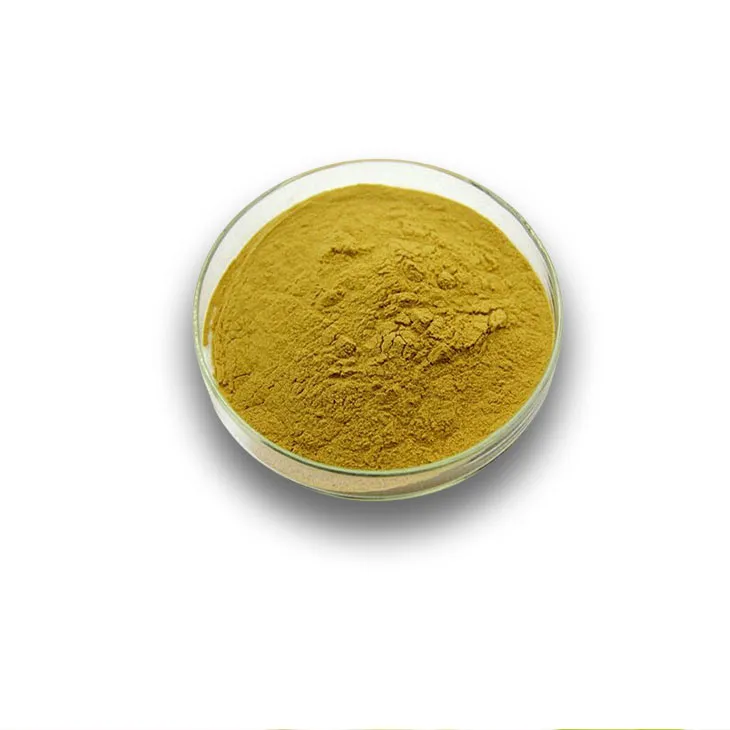- 0086-571-85302990
- sales@greenskybio.com
Honeysuckle pollen: components of fertilizers and feeds.
2024-11-28

1. Introduction
Honeysuckle, a well - known plant, has been used in traditional medicine and gardening for a long time. However, its flower pollen, which is rich in various components, has not been fully explored in terms of its potential applications in fertilizers and feeds. This article aims to comprehensively analyze the components of honeysuckle flower pollen and their significance in the fields of fertilizers and feeds.

2. Components of Honeysuckle Flower Pollen
Honeysuckle flower pollen contains a wide range of components that contribute to its potential uses.
2.1 Proteins
Proteins are one of the major components in honeysuckle flower pollen. These proteins are composed of various amino acids, which are essential for the growth and development of living organisms. In the context of fertilizers, the protein - derived nitrogen can be gradually released into the soil, providing a slow - release source of this crucial nutrient for plants. For feeds, the proteins in honeysuckle flower pollen can be a valuable source of nutrition for livestock, especially for non - ruminant animals that require high - quality protein sources.
2.2 Carbohydrates
Carbohydrates in honeysuckle flower pollen play important roles as well. They can be a source of energy for both plants and animals. In fertilizers, carbohydrates can contribute to the improvement of soil structure. As they are decomposed by soil microorganisms, they help to form humus, which enhances soil fertility, water - holding capacity, and aeration. For livestock, carbohydrates in the pollen can provide the necessary energy for daily activities, growth, and reproduction.
2.3 Lipids
Lipids are also present in honeysuckle flower pollen. These lipids can contain essential fatty acids, which are important for the proper functioning of cells in both plants and animals. In fertilizers, lipids can act as a source of energy for soil microorganisms during the decomposition process. In feeds, the essential fatty acids in the lipids can improve the quality of livestock products such as meat and milk, and also contribute to the overall health and immune function of the animals.
2.4 Vitamins and Minerals
Honeysuckle flower pollen is rich in vitamins and minerals. Vitamins such as vitamin C, vitamin E, and B - group vitamins are present. Vitamin C can act as an antioxidant, protecting cells from oxidative damage in both plants and animals. Vitamin E also has antioxidant properties and is important for membrane stability. B - group vitamins play crucial roles in metabolism. In terms of minerals, elements like potassium, calcium, and magnesium are found in the pollen. Potassium is essential for plant growth and development, helping in functions such as osmoregulation and enzyme activation. For livestock, these minerals are necessary for maintaining proper physiological functions, such as bone formation (calcium) and nerve function (magnesium).

3. Honeysuckle Flower Pollen in Fertilizers
The components of honeysuckle flower pollen make it a potentially valuable ingredient in fertilizers.
3.1 Improving Soil Fertility
When added to the soil, honeysuckle flower pollen can improve soil fertility in multiple ways. As mentioned earlier, the proteins release nitrogen, which is a key nutrient for plant growth. The carbohydrates contribute to the formation of humus, which enriches the soil with organic matter. This improves the soil's ability to retain water and nutrients, making it more fertile. The minerals present in the pollen also supplement the soil's nutrient content, ensuring that plants have access to a balanced supply of essential elements.
3.2 Promoting Plant Growth
The nutrients in honeysuckle flower pollen can directly promote plant growth. The nitrogen from proteins helps in the synthesis of chlorophyll, which is essential for photosynthesis. The energy provided by carbohydrates and lipids supports various metabolic processes in plants. Vitamins and minerals also play important roles in plant growth and development. For example, calcium is necessary for cell wall formation, and potassium is involved in the regulation of stomatal opening and closing, which affects gas exchange and water balance in plants.
3.3 Enhancing Soil Microbial Activity
Soil microorganisms are crucial for soil health and plant growth. Honeysuckle flower pollen can enhance soil microbial activity. The carbohydrates and lipids in the pollen serve as a food source for soil microorganisms. As they decompose the pollen, these microorganisms release nutrients in a form that can be more easily absorbed by plants. Moreover, some of the components in the pollen may stimulate the growth and activity of beneficial soil bacteria and fungi, which can help in suppressing plant diseases and improving soil structure.

4. Honeysuckle Flower Pollen in Feeds
The nutritional value of honeysuckle flower pollen also makes it a potential feed ingredient.
4.1 Nutritional Benefits for Livestock
As a feed ingredient, honeysuckle flower pollen offers several nutritional benefits for livestock. The proteins, carbohydrates, lipids, vitamins, and minerals present in the pollen can supplement the diet of animals. For example, in poultry farming, the high - quality protein in the pollen can improve the growth rate and egg production of chickens. In ruminant animals such as cows, the pollen can provide additional energy and nutrients, especially during periods of high demand such as lactation.
4.2 Improving Livestock Health
The components in honeysuckle flower pollen can also contribute to improving livestock health. The antioxidants such as vitamin C and vitamin E can help in reducing oxidative stress in animals, which is associated with various health problems. The essential fatty acids in the lipids can enhance the immune function of animals, making them more resistant to diseases. Additionally, the minerals in the pollen play important roles in maintaining normal physiological functions, such as muscle contraction and nerve impulse transmission.
4.3 Enhancing Livestock Product Quality
Feeding honeysuckle flower pollen to livestock can potentially enhance the quality of livestock products. In the case of meat production, the essential fatty acids in the pollen can improve the fatty acid profile of the meat, making it more nutritious and healthier for consumers. For milk production, the nutrients in the pollen can increase the milk yield and improve the quality of milk, for example, by increasing the content of certain vitamins and minerals.

5. Challenges and Considerations
While honeysuckle flower pollen has great potential in fertilizers and feeds, there are also some challenges and considerations.
5.1 Collection and Processing
Collecting sufficient amounts of honeysuckle flower pollen can be a challenge. It requires proper techniques to ensure high - quality collection without causing damage to the plants. Additionally, processing the pollen to make it suitable for use in fertilizers or feeds also needs careful consideration. For example, in the case of fertilizers, the pollen may need to be processed to ensure slow - release of nutrients. For feeds, it needs to be processed to ensure safety and palatability for livestock.
5.2 Standardization and Quality Control
There is a need for standardization and quality control in the use of honeysuckle flower pollen in fertilizers and feeds. Different sources of pollen may vary in their component content, so it is important to establish standards to ensure consistent quality. Quality control measures should also be in place to detect any contaminants or harmful substances in the pollen, especially when it is used in feeds.
5.3 Cost - Effectiveness
Evaluating the cost - effectiveness of using honeysuckle flower pollen in fertilizers and feeds is crucial. The cost of collecting, processing, and using the pollen should be balanced against the benefits it provides. In some cases, alternative sources of nutrients or feed ingredients may be more cost - effective, so a thorough economic analysis is required.
6. Conclusion
Honeysuckle flower pollen contains a rich variety of components that have significant potential in the fields of fertilizers and feeds. Its nutrients can improve soil fertility, promote plant growth, and enhance livestock health and product quality. However, challenges such as collection, processing, standardization, and cost - effectiveness need to be addressed. With further research and development, honeysuckle flower pollen could become a more widely used and valuable resource in both the agricultural and livestock industries.
FAQ:
What are the main nutrients in honeysuckle flower pollen?
Honeysuckle flower pollen contains various nutrients such as proteins, amino acids, vitamins (like vitamin C, E, etc.), and minerals (including potassium, calcium, etc.). These nutrients play important roles in both plant growth when used in fertilizers and in providing nutrition for livestock when considered as a feed ingredient.
How does honeysuckle flower pollen enhance soil fertility as a fertilizer component?
The nutrients in honeysuckle flower pollen can be released into the soil gradually. For example, the minerals can improve the soil structure, and the organic matter in it can increase the soil's water - holding capacity. The proteins and other substances can also be decomposed by soil microorganisms, providing a continuous source of nutrients for plants, thus enhancing soil fertility.
Is honeysuckle flower pollen safe for livestock as a feed ingredient?
When used appropriately, honeysuckle flower pollen can be safe for livestock. However, it is necessary to ensure that there are no harmful substances such as pesticides or excessive amounts of certain elements. Also, proper processing and mixing with other feed ingredients are required to meet the nutritional needs of livestock without causing any adverse effects.
How can honeysuckle flower pollen be processed for use in fertilizers?
One common method is to dry the honeysuckle flower pollen first to preserve its nutrients. Then it can be ground into a fine powder. This powder can be directly added to the soil or mixed with other organic or inorganic substances to form a more comprehensive fertilizer. Some advanced processing may also involve extraction of specific active ingredients for more targeted fertilization.
What are the potential challenges in using honeysuckle flower pollen in feed?
One challenge is ensuring consistent quality. Since the nutrient content of honeysuckle flower pollen may vary depending on factors like the growth environment and harvesting time, it is difficult to maintain a uniform quality. Another challenge is cost - effectiveness. The collection and processing of honeysuckle flower pollen may be relatively costly, which may limit its large - scale use in feed.
Related literature
- The Nutritional Components of Honeysuckle Flower Pollen"
- "Honeysuckle Flower Pollen in Agriculture: Fertilizer Applications"
- "Utilizing Honeysuckle Flower Pollen as Livestock Feed: A Review"
- ▶ Hesperidin
- ▶ Citrus Bioflavonoids
- ▶ Plant Extract
- ▶ lycopene
- ▶ Diosmin
- ▶ Grape seed extract
- ▶ Sea buckthorn Juice Powder
- ▶ Fruit Juice Powder
- ▶ Hops Extract
- ▶ Artichoke Extract
- ▶ Mushroom extract
- ▶ Astaxanthin
- ▶ Green Tea Extract
- ▶ Curcumin
- ▶ Horse Chestnut Extract
- ▶ Other Product
- ▶ Boswellia Serrata Extract
- ▶ Resveratrol
- ▶ Marigold Extract
- ▶ Grape Leaf Extract
- ▶ New Product
- ▶ Aminolevulinic acid
- ▶ Cranberry Extract
- ▶ Red Yeast Rice
- ▶ Red Wine Extract
-
Lotus leaf extract
2024-11-28
-
Calendula Extract
2024-11-28
-
Acerola Extract
2024-11-28
-
Hericium erinaceus extract powder
2024-11-28
-
American Ginseng Root Extract
2024-11-28
-
Okra Extract
2024-11-28
-
Green Tea Extract
2024-11-28
-
Lemon Extract
2024-11-28
-
Uridine-5'-monophosphate Disodium salt
2024-11-28
-
Citrus bioflavonoids
2024-11-28





















